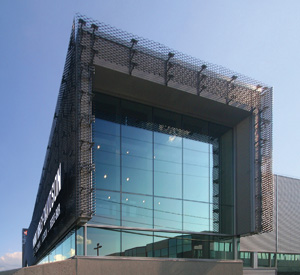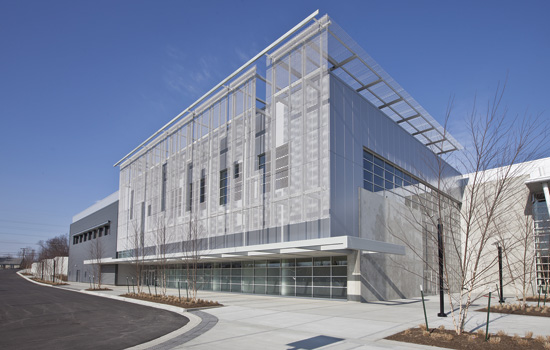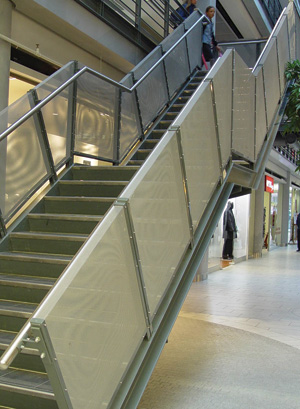Expanded Metal Mesh in Architecture
 |
Expanded metal mesh used as building cladding such as on this Harley Davidson facility in Quebec creates a striking and functional façade treatment. Photo courtesy of AMICO |
Diamond patterned expanded metal mesh is typically referred to by size and style using standard recommended nomenclature further defined within the NAAMM standard as follows:
- Industrial Diamond Patterns: Carbon Steel — The first numerals express the Style or Design: (Example: 3/4” # 9). The letter S or F following the Style or Design designates “Standard” or “Flattened” Expanded Metal. For stainless steel, the designation will be the same except that the stainless steel type must be specified (Example: 304, 316, etc.). Similarly, for aluminum the nomenclature will follow that of carbon steel except the exact decimal equivalent of the aluminum is used to specify thickness.
- Small Diamond Designs — up to 3/16 inch. The industry nomenclature is essentially the same as Industrial Diamond Patterns described above except that the strand width is designated.
- Decorative or architectural mesh can vary widely since it is usually designed and detailed by a manufacturer. Consult manufacturers directly for available patterns.
- Fine Mesh is also usually designed and specified by manufacturer. Similarly, consult the manufacturer for available patterns and sizes. When using the NAAMM Standard to refer to expanded metal mesh, a complete designation is appropriate to avoid possible error. SWD dimension is always given before LWD dimension:
- Example: ½” #20 S (Standard), Carbon Steel 4” SWD x 8” LWD
Design Applications
The key design trait of expanded metal mesh is its versatility. The technical and manufacturing aspects of the product allow for custom fabrications but without a custom price tag. Hence it is enjoying a variety of uses in buildings.
Uses of expanded metal products fall into five principal areas: enclosure, protection, support, decoration and filtration. The light weight and strength of expanded metal make it an ideal material for a wide variety of commercial and industrial security applications such as storefront protectors, stairway and warehouse enclosures, lockers and tool room partitions. It is also particularly valuable in the construction of safety guards for equipment with high heat buildup or where ventilation is required. In addition to all of these, there are a growing number of applications where the use of expanded metal mesh is making a design statement and enhancing the overall building design such as those discussed below.
 |
The Southland Christian Church benefits from the solar screening capabilities of aluminum expanded metal mesh to shield the façade and building interior from excess solar gains. Photo courtesy of AMICO |
Building Exterior Uses
Expanded metal is an ideal material for use on building exteriors. As a material used by any design architect, it can be used to turn even the most challenging of building types into a work of art. And since the metal is available in a range of durable and long lasting choices, it is able to withstand the rigor of exposure to weather, wind, and other environmental factors. Some of the more popular ways expanded metal mesh is used on building exteriors include the following:
 |
Expanded metal mesh is used on exterior and interior stairs as a full protection balustrade contributing to both safety and aesthetics. Photo courtesy of AMICO |
- Exterior Cladding: Expanded metal exterior cladding has become particularly popular over recent years and can be seen on many buildings such as The New Museum of Contemporary Art in New York City or The Young Vic Theatre in London. The designers of these buildings have discovered the ability of expanded metal mesh to act as both a visually appealing building façade material as well as an effective element of a wall assembly. Depending on the type and size of the openings, it can act as a very open and self-ventilating rainscreen over appropriate substrates. It can also provide protection to building elements that may be concealed below. In the process, it provides a wide range of choices for the finished appearance of the building that can change with changing conditions of natural and artificial light. Traditionally, expanded metal mesh has been used to act as a support substrate for plaster and stucco. Taking these uses one step further, manufacturers have developed the material to act in a supporting role on much larger projects. Expanded metal can be curved in both elevation and plan to create a shaped and sculptured structure or add strength and support to exterior cladding used on building facades.
- Solar Screening: In many commercial and institutional buildings, daylight is welcome as part of an indoor environment and as an alternative to electric lighting. However, the heat associated with sunlight is not always welcome nor is the glare and intensity of direct sunlight. Hence, architects have turned to numerous methods to deflect unwanted solar gains on building facades ranging from overhangs to glass treatments and others. Expanded metal mesh has been effectively providing this function as well when placed on the outside of a glazed building facade. Since the pattern of the openings and the depth of expanded metal mesh are all variable and customizable, it is possible to use it to create some very effective and innovative solar screening. For example, by arranging the size and shape of the diamonds in an expanded metal mesh it is possible to use the strands to deflect direct sunlight and cast shadows on glazing while using the apertures or openings to still provide views and allow diffuse or reflected daylight to enter the building. Further, the pattern can be adjusted as appropriate to address different orientations on different sides of the building such that the level of shading vs. daylighting can be optimized for each side.
- Ventilation: In certain cases daylight is not the design driver, rather, ventilation with a semblance of enclosure is needed. This would be the case in structures that don’t seek full enclosure such as parking garages or outdoor pavilions for example. Some security and protection are needed but so are ventilation and a sense of openness. Using expanded metal mesh can provide exactly that function on these structures by allowing air to flow freely through the openings in the mesh and even be directed by the angle of the mesh or the shape of the metal strands. And it can be installed in lieu of any other enclosure material without the need for any glazing. In effect it becomes a large scale screening that can meet all of the functional needs while providing an array of visual opportunities. The building can be enveloped in this material in a whole variety of artistic and creative designs causing an effect of greater articulation of design elements, more three dimensional appearances, and greater design impact overall.
- Exterior Balustrades: On exterior stairways, a means of filling in the balustrade area so that it is more fully enclosed for safety is often desirable while still wanting to create a visually appealing solution. Expanded metal mesh has been used in a number of different balustrade applications for commercial, industrial and institutional buildings with rather successful results. The variety of meshes, materials and finishes available make it quite possible to meet or exceed all code requirements for stairway and landing guard rails while still addressing the aesthetic design needs of a building.









